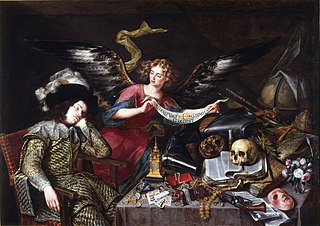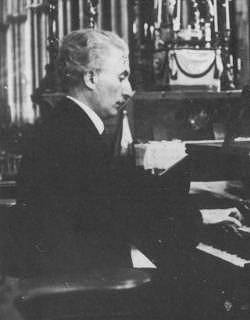Related Research Articles

Jean Victor Arthur Guillou was a French composer, organist, pianist, and pedagogue. Titular Organist at Saint Eustache in Paris, from 1963 to 2015, he was widely known as a composer of instrumental and vocal music focused on the organ, as an improviser, and as an adviser to organ builders. For several decades he held regular master classes in Zurich and in Paris.
Louis Thiry was a French concert organist, composer and pedagogue. He was professor of organ at the Regional Conservatoire in Rouen and played in concerts internationally. His many recordings include the complete organ works of Olivier Messiaen in 1972, which received several awards and led the composer to describe him as "an extraordinary organist". Thiry was blind.

Antonio de Pereda y Salgado was a Spanish Baroque-era painter, best known for his still lifes.

François Benoist was a French organist, composer, and pedagogue.

Joseph Pérez was a French historian specializing in Spanish history. Pérez specialized in the births of the modern Spanish state and the Latin American nations. Among his books, he examined the independence movements of Latin America; Ferdinand and Isabella, the Catholic Monarchs; Holy Roman Emperor Charles V, and Philip II of Spain.

Édouard Commette was an organist from Lyon in France of international fame who served the Archdiocese of Lyon and was organist at Basilique Notre Dame de Fourvière for over 50 years.

Julián Juderías y Loyot was a Spanish historian, sociologist, literary critic, journalist, translator and interpreter.
Félix Fourdrain was a French organist and composer. He is chiefly known for his operas. Many of them were written in collaboration with librettists and poets Arthur Bernède and Paul de Choudens; the best of which are La Glaneuse, Madame Roland, and Vercingétorix. His masterpiece, La légende du Point d'Argentan, premiered at the Opéra-Comique in Paris in 1903.
René Drouard de Bousset (1703–1760) was a French Baroque composer and organist. He was born in Paris on 12 December 1703.
Rodrigo Méndez Silva (1606–1670) was a Spanish historian, genealogist, geographer and writer.
José Lidón, or Josef Lidón, or José Lidón Blázquez, born in Béjar, Salamanca on June 2, 1748, died in Madrid on February 11, 1827, was a Spanish composer, organist and conductor.

Bernard Foccroulle is a Belgian organist, composer, conductor and opera director. He was born in Liège and studied at the Conservatoire de Liège. Initially, he became known as a member of the Ricercar Consort. He was president of the Jeunesses musicales, and in 1992, he was named director of the Théâtre royal de la Monnaie.
Guillaume Lasceux was a French organist, improviser and composer.
Antoine Louis Raffy was a French composer of church music and organist.
Henri Jules Joseph Nibelle was a French organist, choral conductor and composer.
Ernest Grosjean was a French organist and composer.

Hervé Désarbre is a French organist and organiste du ministère de la Défense [organist of the Ministry of Armed Forces]. He is titular of the Cavaillé-Coll organ of the Église Notre-Dame du Val-de-Grâce in Paris.

Jeanne Joulain was a French organist, concertist and music educator.
Noëlie Pierront was a 20th-century French organist, concertist and music educator.

Children in a Chariot is a 1779 painting by Francisco de Goya. It is part of the third series of cartoons he produced for tapestries at the Royal Palace of El Pardo; the tapestry in question was to be positioned over a door. The painting is in the Toledo Museum of Art.
References
- ↑ Pedro Carrera y Lanchares
- ↑ Biographie universelle des musiciens François-Joseph Fétis, Arthur Pougin - 1875 "CARRERA Y LANCHARES (Le P. Maithe Fn. Pedro), organiste du couvent des Carmes chaussés de Madrid, fut élève de D. Joseph Lidon , organiste de la chapelle royale , et vécut dans la seconde moitié du dix-huitième siècle. En 1792 il ..."